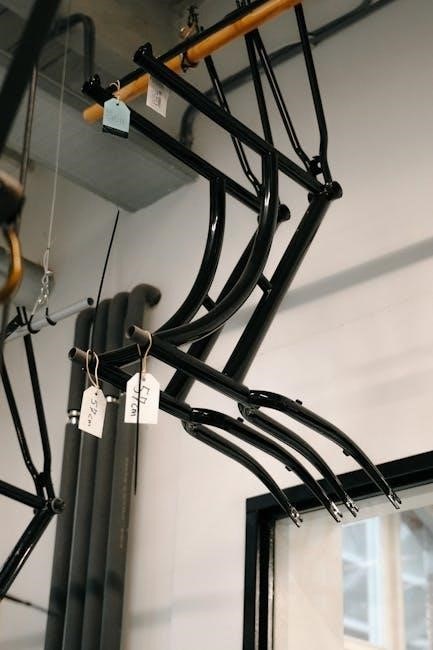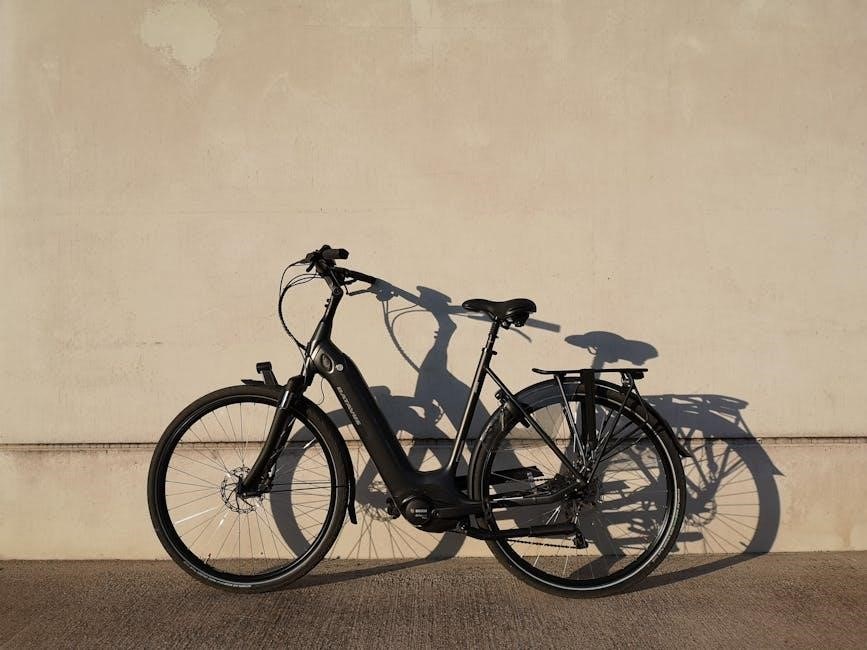Choosing the right bike frame size is crucial for comfort and performance. This guide helps you understand how to measure and select the perfect fit based on height, inseam, and bike type, ensuring an optimal riding experience.
Understanding the Importance of Proper Bike Fit
A proper bike fit is essential for both comfort and performance. An ill-fitting bike can lead to discomfort, reduced efficiency, and even long-term health issues like back pain or wrist strain; A well-fitting bike ensures optimal control, power transfer, and endurance, making your riding experience more enjoyable. Proper fit also enhances safety by allowing better handling and maneuverability. Whether you’re a casual rider or a professional cyclist, investing time in finding the right bike size is crucial. This guide provides detailed insights and tools to help you achieve the perfect fit, ensuring every ride is comfortable and efficient.

Overview of Bike Frame Sizes and Types
Bike frame sizes and types vary to cater to different riding styles, terrains, and preferences. Common bike types include road, mountain, hybrid, BMX, and electric bikes, each with unique frame designs. Road bikes feature sleek, lightweight frames for speed, while mountain bikes have sturdy frames built for durability on rough terrain. Hybrid bikes offer a versatile design, combining elements of both road and mountain bikes. BMX bikes are smaller and designed for tricks or racing, whereas electric bikes include motors for assisted pedaling. Frame sizes are typically measured in inches and vary depending on the bike type and intended use. Understanding the differences in frame geometry and materials helps riders choose the best option for their needs, ensuring a comfortable and efficient riding experience.

How to Measure for a Bike
Measuring for a bike involves assessing your height, inseam, and bike type to ensure a proper fit. This guide helps you determine the ideal size accurately.
Measuring Your Height Accurately
Accurate height measurement is essential for determining the right bike frame size. Stand upright against a flat surface, feet shoulder-width apart, and measure from the floor to the top of your head. Use a flexible tape measure or a wall-mounted ruler; Ensure your posture is straight with shoulders relaxed and ears, shoulders, hips, and ankles aligned. Record the measurement in inches or centimeters. This data is crucial for consulting bike size charts, which often categorize frame sizes based on height ranges. Proper measurement ensures a comfortable and efficient riding position, reducing the risk of discomfort or injury. Always double-check your height measurement for accuracy before selecting a bike size.
Understanding Inseam and Its Role in Bike Sizing
Inseam, the distance from the floor to the crotch while standing, plays a crucial role in bike sizing. It determines standover clearance, ensuring the bike fits comfortably and safely. To measure inseam, stand straight, feet shoulder-width apart, and place a hardcover book or ruler between your legs, flush against the crotch. Measure the distance from the floor to the top of the book. This measurement helps calculate the ideal bike frame size, especially for road and mountain bikes. A proper inseam ensures the bike is neither too small nor too large, allowing for optimal control and maneuverability. Variations in inseam among individuals with the same height highlight its importance in achieving a precise fit. Always use this measurement alongside height for accurate bike sizing, as it directly impacts comfort and performance.
How to Use a Bike Size Chart Effectively
To effectively use a bike size chart, start by accurately measuring your height and inseam. Ensure you’re using the correct chart for your bike type, as road bikes and mountain bikes may have different sizing standards. Standover clearance, the distance from the floor to the bike frame while standing over it, is crucial for safety and comfort. Match your inseam to the recommended standover clearance on the chart. If your height falls between sizes, consider your riding style: a more aggressive position may require a smaller frame, while a relaxed position might suit a larger one. For precise fit, double-check measurements and consider using online tools or calculators if a physical chart isn’t available. This ensures optimal comfort and performance tailored to your body and riding preferences.
Bike Frame Size Charts

Bike frame size charts provide standardized measurements to match height, inseam, and frame size in inches for optimal fit across different bike types and brands.
Standard Bike Frame Size Chart for Adults
A standard bike frame size chart for adults typically categorizes frames by inches, ranging from 14″ to 23″, designed to fit riders of various heights. The chart aligns height ranges with corresponding frame sizes, ensuring a proper fit. For example, a 14-15″ frame suits shorter riders (4’11”-5’3″), while a 20-21″ frame fits taller individuals (5’9″-6’2″). Inseam and standover clearance are also considered, with most frames requiring 1-2 inches of clearance for safety and comfort. Road bikes often use smaller frames, while mountain bikes may have slightly larger frames for stability. This chart serves as a universal guide, helping cyclists choose the right size based on their measurements and riding style. Always test ride a bike to confirm fit, as personal comfort can vary.
Bike Frame Size Chart for Kids
Choosing the right bike frame size for kids involves considering their height, inseam, and age. A standard bike frame size chart for children typically ranges from 12″ to 24″ wheels, with sizes increasing as the child grows. For younger kids (ages 3-5), a 12-14″ wheel size is ideal, while older children (ages 6-8) often ride 16-18″ bikes. Preteens (ages 9-12) may prefer 20-24″ bikes. Height plays a crucial role; for example, a 16″ bike suits children 42-48″ tall, and a 20″ bike fits those 50-54″ tall. Ensure the child can stand over the bike with 1-2 inches of clearance for safety. Allow room for growth, but avoid bikes that are too large, as they can be difficult to control. Always test the fit and adjust handlebars or seats if necessary. Proper fit ensures comfort and confidence for young riders.
Differences in Frame Sizes for Men and Women
Bike frame sizes differ between men and women due to anatomical variations. Women’s frames are designed with shorter top tubes and narrower handlebars to accommodate shorter torsos and narrower shoulders. They often feature a shorter standover height and a more relaxed geometry for comfort. Men’s frames typically have longer top tubes, wider handlebars, and steeper seat tube angles for efficiency and power. Women’s bikes may also have shorter crank arms and adjusted saddle positions for better fit. While these differences are general, individual body proportions vary, and some riders may prefer frames designed for the opposite gender. Ultimately, proper fit is more important than gender-specific designs. Always test ride a bike to ensure comfort and performance, regardless of frame type. This ensures optimal riding experience tailored to personal needs. Correct sizing enhances both safety and efficiency for all riders. Adjustments can further fine-tune the fit.

Choosing the Right Bike Type
Selecting the appropriate bike type is crucial for optimal performance and comfort. Consider your riding style, terrain, and body proportions to ensure a perfect match. Proper fit enhances efficiency and safety, making every ride enjoyable and tailored to your needs. Always prioritize comfort and functionality when deciding on a bike type.
Road Bike Frame Size Guide
Choosing the right road bike frame size is essential for optimal performance and comfort. Road bikes are designed for speed and efficiency, with frame sizes typically ranging from 47cm to 63cm. To determine your ideal size, measure your height and inseam, then consult a road bike size chart. Standover clearance is crucial—1-2 inches for a comfortable fit. Riders with longer torsos may prefer a slightly larger frame for better ergonomics. Test rides are recommended to ensure the bike feels right. Proper sizing enhances aerodynamics, power transfer, and overall riding experience. Always consider personal comfort and riding style when selecting your road bike frame size.
Mountain Bike Frame Size Guide
Mountain bike frame sizes typically range from 13 to 23 inches, catering to various rider heights and preferences. To find your ideal size, start with your height and inseam measurements. Standover clearance is critical for mountain bikes, with a recommended 2-4 inches for safety and maneuverability. Cross-country bikes often favor smaller frames for agility, while downhill bikes may suit taller riders for stability. Use a size chart to align your height with the appropriate frame size, ensuring comfort and control on trails. Test rides are highly recommended to confirm the best fit for your riding style and terrain. Proper sizing enhances handling, efficiency, and overall performance on the mountain bike.
Hybrid Bike Frame Size Guide
Hybrid bikes, designed for versatility, typically have frame sizes ranging from 15 to 23 inches. To determine the ideal size, consider your height and inseam. Use a bike size chart to align these measurements with the appropriate frame size, ensuring a comfortable and efficient riding position. Standover clearance is crucial, allowing 2-4 inches for safety and ease of use. Hybrid bikes cater to commuting, fitness, and casual rides, often featuring an upright posture. The top tube length and seat tube length are key factors, with the seat tube usually being the measured size. For example, a 19-inch frame might suit riders around 5’9″ to 6’1″. Always test ride a bike to confirm fit, as personal comfort can vary. Proper sizing enhances the overall riding experience, making hybrid bikes ideal for diverse terrains and purposes.
BMX and Electric Bike Frame Size Guide

BMX bikes typically feature smaller frames, ranging from 12 to 24 inches, catering to stunt, racing, and freestyle riding. The frame size is often chosen based on rider height and personal preference, with taller riders opting for larger frames. Electric bikes, on the other hand, vary widely in size, often between 16 to 20 inches, depending on the model and intended use. Folding e-bikes may have smaller frames for portability, while cargo e-bikes may be larger. When sizing an e-bike, consider standover height and comfort, as these bikes are designed for efficiency and practicality. Always consult the manufacturer’s sizing chart and test ride if possible to ensure the best fit for your needs and riding style.

Advanced Sizing Considerations
Advanced sizing involves precise measurements, including ape index and standover clearance, ensuring optimal comfort and performance. Frame geometry, handlebar height, and seat adjustments are critical for tailored fit.
Using an Ape Index Calculator for Better Fit
An ape index calculator measures the difference between your arm span and height, aiding in determining handlebar width and bike frame size for optimal cycling comfort. It helps cyclists with longer or shorter arm spans relative to their height find a better fit, enhancing control and efficiency. While primarily a starting point, it’s most effective when combined with other sizing methods like bike size charts or professional fittings. Available online or through bike shops, these calculators provide personalized recommendations, though they may not account for all body proportions. They are particularly useful for road and mountain bikes, where handlebar width significantly impacts performance. Use an ape index calculator to refine your bike setup for a more comfortable and efficient ride.

Understanding Bike Geometry and Its Impact on Size
Bike geometry refers to the measurements and angles of a bike’s frame, which significantly influence how it rides and fits. Key factors include wheelbase, head tube angle, seat tube angle, and standover height. These measurements determine stability, maneuverability, and comfort. For example, a longer wheelbase improves stability but may reduce agility, while a steeper head tube angle enhances handling for road bikes. Seat tube angle affects pedaling efficiency, and standover height ensures safe clearance. Understanding these aspects helps riders choose a frame size that aligns with their riding style and body proportions. Different bike types (road, mountain, hybrid) have distinct geometries, so matching your needs to the right geometry ensures optimal fit and performance. Proper geometry alignment is crucial for comfort and efficiency.
How to Adjust Handlebars and Seat Height for Comfort
Properly adjusting handlebars and seat height is crucial for a comfortable and efficient riding experience. Start by setting the saddle height so your leg is nearly fully extended at the pedal’s lowest point, with a slight bend for comfort. Use bike size charts as a guide but fine-tune based on personal preference. For handlebars, adjust the height and angle to suit your riding style—upright for comfort or lower for aerodynamics. Consider using spacers to raise or lower the bars without altering the stem. Ensure the handlebars are level or slightly tilted upward for optimal ergonomics. Experiment with these adjustments to find a balance between comfort and performance, and always test ride after making changes to ensure the perfect fit.

Specialized Sizing Needs
Bike sizing varies for women, children, and riders with specific needs. Proper fit ensures comfort and efficiency, addressing unique body proportions and riding styles effectively.
Women-Specific Bike Frame Sizes
Women-specific bike frames are designed to accommodate the unique body proportions of female riders. These frames typically feature shorter top tubes and shorter reaches to reduce strain on the neck and shoulders, allowing for a more comfortable riding position. Standover height is also a critical factor, as women generally have a lower center of gravity. When determining the correct size, measurements such as inseam, arm length, and riding style are essential. Most women’s bikes are sized using the same inch or centimeter system as unisex frames, but the geometry is tailored for better fit. For example, a woman with a 28-inch inseam might prefer a 14-inch or 15-inch frame. Always consult a size chart or a professional fitter to ensure the best fit, as personal comfort and riding efficiency are paramount. Test rides are highly recommended to confirm the ideal size and geometry.
Children’s Bike Frame Size Guide
Children’s bike frame sizes are typically determined by wheel size rather than frame dimensions, with options ranging from 12 inches to 24 inches. A 12-inch bike is suitable for younger kids (2-4 years), while a 16-inch bike fits children aged 4-6 years; Older kids (6-8 years) often ride 20-inch bikes, and 24-inch bikes are for preteens (8-12 years). Standover height is crucial; the child should have 1-2 inches of clearance when standing flatfooted. Sizing also considers the child’s inseam and reach. Some bikes offer adjustable features to grow with the child. Always ensure the bike is lightweight and easy to handle, as this improves safety and confidence. Test rides are recommended to confirm the best fit, ensuring comfort and proper posture for young riders. This approach helps in selecting a bike that supports their growth and riding development. Proper sizing enhances both safety and enjoyment for children.
Bike Sizing for Different Riding Styles
Bike sizing varies significantly based on riding style and terrain. Road bikes prioritize aerodynamics and efficiency, requiring a slightly larger frame for taller riders to maintain an aggressive posture. Mountain bikes focus on maneuverability and stability, often favoring a smaller frame size for better control on rough trails. Hybrid bikes strike a balance, offering a medium frame size for versatility in both urban and light off-road settings. Gravel or touring bikes may use a slightly longer frame for comfort during long rides. The rider’s height and inseam are key, but riding style dictates the ideal fit. For example, a road cyclist may prefer a larger frame for speed, while a mountain biker might opt for a smaller one for agility. Always consider how the bike’s geometry aligns with your riding goals. Test rides are essential to ensure the frame size matches your style and terrain preferences. Proper sizing enhances performance and comfort across all disciplines.
Tools and Resources
Utilize online bike size calculators, printable charts, and specialized apps to determine your ideal frame size accurately, ensuring a perfect fit tailored to your riding style and comfort.
Online Bike Size Calculators
Online bike size calculators are invaluable tools for determining the perfect frame size. These calculators typically require basic measurements, such as height, inseam, and riding style, to provide a precise frame size recommendation. Many websites offer free, user-friendly calculators that cater to different bike types, including road, mountain, and hybrid bikes. By inputting your data, you receive instant results, often with suggestions for handlebar height and standover clearance. Some calculators also account for personal preferences, like aggressive or relaxed riding positions. They save time and eliminate guesswork, ensuring a comfortable and efficient fit. For accuracy, it’s essential to double-check your measurements before using these tools. Online calculators are a modern, convenient way to find your ideal bike size without visiting a store. They’re especially useful for comparing sizes across brands and models.
Printable Bike Size Charts
Printable Bike Size Charts

Printable bike size charts are a convenient and practical tool for cyclists to determine their ideal frame size. These charts are easily downloadable and can be printed at home, providing a quick reference guide. They typically include measurements in inches, catering to various bike types such as road, mountain, and hybrid bikes. By measuring your height and inseam, you can cross-reference the chart to find the recommended frame size. Many charts also differentiate between men’s and women’s frames, ensuring a better fit. Printable charts are especially useful for those who prefer a tangible resource or need to compare sizes across multiple brands. They offer a straightforward, no-tech solution for finding the perfect bike size, making them a valuable resource for both novice and experienced cyclists.
Apps for Measuring and Sizing Bikes
Apps for measuring and sizing bikes are innovative tools that simplify the process of finding the perfect frame size. These applications often use algorithms to calculate ideal bike dimensions based on your height, inseam, and riding style. Many apps, such as Bike Size Calculator and SizeMyBike, allow users to input their measurements and receive recommendations for frame sizes in inches. Some apps also offer virtual bike fitting, enabling you to visualize how different bikes will fit your body. Additionally, apps like BikeRadar and others provide detailed size charts and calculators specifically for road, mountain, and hybrid bikes. These tools are particularly useful for comparing sizes across brands and ensuring accuracy. By leveraging technology, apps make bike sizing more accessible and efficient, helping cyclists achieve the perfect fit for comfort and performance.
Final Tips for Ensuring the Perfect Fit
To ensure the perfect fit, always start with a test ride to gauge comfort and control. Adjust the seat height so your leg is nearly fully extended at the pedal’s lowest point. Handlebars should align with your comfort, whether upright for casual rides or lower for performance. Consider consulting a professional fitter to fine-tune your setup. Regularly check and maintain your bike to prevent issues like saddle wear or brake maladjustment. Personalize your bike by adding accessories like ergonomic grips or saddles tailored to your riding style. Remember, even small adjustments can significantly impact your cycling experience. Prioritize comfort and efficiency for long-term enjoyment on the road or trail.
Importance of Test Rides
A test ride is essential to confirm that your bike fits perfectly and meets your riding needs. It allows you to assess how the bike feels in real-world conditions, ensuring comfort and control; Pay attention to how the bike handles, accelerates, and brakes. Check if the saddle height and handlebar position feel right, and whether you can maintain a comfortable riding posture. A test ride also helps you identify any potential issues, such as frame size or geometry that may not suit your body or riding style. Don’t rely solely on size charts—always take a bike for a spin before purchasing. This step ensures a more enjoyable and efficient cycling experience, tailored to your unique preferences and requirements.
How to Maintain Proper Fit Over Time
Maintaining proper bike fit over time is crucial for comfort, efficiency, and injury prevention. As your body changes or your riding style evolves, regular adjustments are necessary. Start by reassessing your bike fit every 6-12 months, especially if you’ve experienced weight changes, injuries, or shifts in riding habits; Adjustments may include tweaking seat height, handlebar position, or cleat alignment. Monitor your posture while riding to ensure it remains comfortable and efficient. Additionally, consider scheduling a professional bike fit periodically to account for any physical changes. Regular maintenance of your bike, such as checking bolt tightness and tire pressure, also plays a role in ensuring optimal performance. By staying proactive, you can enjoy a consistent and enjoyable riding experience tailored to your needs over time.